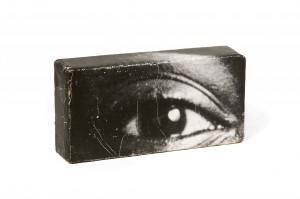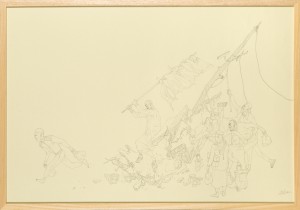The most famous bricks are perhaps the ones thrown by Ignatz, George Herriman’s irreverent mouse, at Krazy Kat, his love object. Issued from a seemingly endless pile and zipped through the air, these weighty missives rarely missed their target – Krazy’s Kat’s head – and exploded into floating hearts. Launched in cartoon world, the brick is a metaphor, of course, for ideas. So it was with delicious irony that I attended and immensely enjoyed 100 Briques Pour Madagascar, an artist benefit auction at Artcurial where very well-heeled French art collectors threw money at bricks.
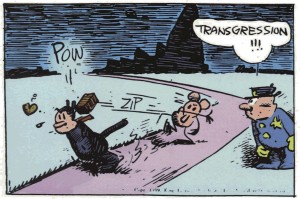
The brainchild for this benefit sale came from Charles Gassot, director of the non-profit Ecoles du Monde (Schools of the World). A contemporary art collector himself, Mr. Gassot says he had the idea about two years ago and approached American conceptual artist Lawrence Weiner about his idea to hand out 100 bricks to artists to aid Madagascar in building schools. “And you guessed it, all our schools are built with bricks – made on site in Madagascar,” adds Gassot. Weiner, whose texts are often pasted onto walls (and sometimes brick walls) immediately said yes. American artist Mark Dion, famous for excavating bricks, also signed on, and the auction came together quickly with many French street artists (no wonder) in particular finding the format extremely appealing. The Parisian public did too: At 8 pm on Monday March 28 maybe 500 people jammed into the bidding room, filling all the bridge chairs, the aisles and most of the available floor space.
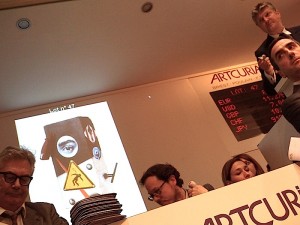
Each brick was featured on a number of video screens (as well as on the Internet), starting off its public life as an object worth 500 euros. Head auctioneer, François Tajan offered without a trace of irony free-flowing adjectives that began with “Voilà! Quelle jolie brique…” [“Here it is… Look at this beautiful brick.”] Needless to say with an A-list of international and up-and-coming French artists the locals nodded “Yes!” and bid up the entire sale to some 562,400 euros ($800,000), all of which went to Ecoles du Monde to build schools in the island nation of Madagascar.
Artcurial would take no premium from the sale, and the artists of course, donated their brickworks. Madagascar which floats just off the southeast coast of Africa is where nearly all the world’s vanilla beans are farmed; however, some 90 percent of its population of about 20 million lives on $2 a day. One can easily imagine how far a school will go to serve that country’s children. So the challenge was to create a buzz in Paris about 100 Bricks. Posters were distributed and the network of collectors contacted, recontacted and then contacted again with a sleek catalog on paper, and another – an overweight PDF sent out by e mail. Charles Gassot says that the reason why the auction attracted so many is because “the brick is universal.” It’s hard to argue with success. He’s currently planning another auction for Madagascar in Paris in two year’s time and is considering other cities to hold auction benefits. “Why not in New York?” adds Gassot.
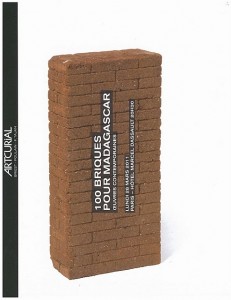
If New York doesn’t have an excess of bricks (it does, don’t worry), it certainly is piled high with art collectors. I attended one of the first giant art auctions at Sotheby’s in New York City in 1987 – ART AGAINST AIDS – headlined by a glittering Elizabeth Taylor and more than 100 artists; Carl Andre designed the catalog. It was a stunning New York art world event. Millions were raised for AMFAR, the research arm dedicated towards finding a cure for AIDS, and then everyone went off to dinner at one of some 30-odd restaurants scattered around Manhattan.
The cocktail of high-value art + collectors to benefit sick and dying people proved to be a winner. The collectors get the art and a fat tax deduction while the sick and dying get medical attention (or in the case of AMFAR, medical research). And the artists, of course, get to align their stars with a good cause and their names and art works in a collector’s home. Everybody wins. The art benefit auction has since become a staple of the art world. Not an autumn passes without a show of “postcards from the edge” or small canvases, boxes, shoes, t-shirts, prints or any other product manufactured by artists to support any of hundreds of worthy causes from playgrounds to seniors to hospitals to vets. The art benefit auction is a high-end bake sale that keeps on giving.
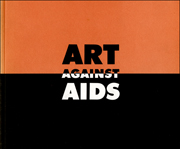
The brick theme, however, is indicative of a new kind of group show, one that probably stems from the Surrealists’ Exquisite Corpse where four artists work blind to produce a drawing that is weirdly mismatched but interesting. If the bricks were to be used to build a house, perhaps such a corpse would be equally surreal, but think more in terms of post card group shows on the theme of Ecology, Peace, Women’s Rights, or even Death. Some years ago I was FED EX’d a canvas here in Paris for a group benefit in Connecticut. There were 500 identically-sized canvases, each offered in a silent auction. I have no idea what happened to the piece of Stalin with Flowers I produced or how much money it raised. Never received a thank you either. Same thing for a piece I donated to an auction in Chicago. Not a word after they received my work. But call me Krazy…
At first I thought the Paris auction 100 Briques was an artist call for brick works! So I immediately plotted a dozen strategies. Pulverize the brick into dust, wrap the brick up in a glass house, make 100 small bricks out of the one big brick, tuck a brick in a baby stroller, mail a brick to French First Lady Carla Bruni (and offer up the return-to-sender piece), or just collage a photo of a brick onto a brick to illustrate Frenchman Derrida’s simulacrum. Crestfallen I was when I learned that the auction was by invitation only, and all the artists were chosen. Rats. the good news is that 100 Bricks For Madagascar was extremely public, and viewable live on the Internet. My guess is that fewer artists will toss their works into some benefit auction affair without documentation either online or in a printed catalog. That said, 100 Bricks proved to be compelling on many fronts.
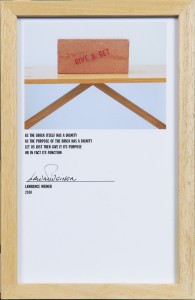
Two American collector friends, Alex Ernst and Garret Siegel, had a catalog and invited me to go with them. They were interested in several bricks. Once squashed into the bidding room, Garret and I went through the catalog. Most featured photos glued on the bricks; another had a hole in it and an egg perched inside, others were chipped, scored into a grid, painted gold or white, drawn on, featured trace marks of the artist or served as pedestals to some other art work the artist was well known for. Several artists offered drawings, water colors or photographs of bricks. One drawing showed angry folks throwing bricks – a nod to Ignatz, perhaps?
In fact there were more than 100 bricks in the auction and one artist emerged from the crowd to offer a brick he’d done that day into the auction. He was duly filmed as auctioneer François Tajan generously accepted the brick (it was later sold for 400 euros). At roughly 8 PM, the parade of bricks and the machine gun fire of bids began – from the floor just beneath a bank of Artcurial worker bees taking bids via telephone and Internet across the planet.
I was stunned to see a drawing of a cartoon character by Enki Bilal scream towards 19,000 euros. I’d never even heard of the Serbian-born, French comic book artist. Lawrence Weiner’s brick featured a text: “GIVE & GET” and documentation, and soared to 20,000 euros; Giuseppe Penone’s brick was treated with (I believe) the artist’s finger prints on its edges; French sculptor Bernar Venet laid three curved ceramic stalks across his brick creating a frenzy that topped 27,000 euros.
J.R., the French street artist who is now famous for his TED Conference lecture about how he has plastered enormous black and white portraits of locals on the steps and walls and rooftops of their cities pulled in 12,500 euros for his photograph of an eye covering his brick. Peter Klasen turned his brick into a construction site with tools and signs: 14,500 euros. But French artists by and large prevailed. Space Invader (who was featured in the film about street artists, Exit Through The Gift Shop), produced a signature work on a brick and earned 15,000 euros for Ecoles du Monde. Architect Jean Nouvel had a golden touch for his “construction” and netted 6,500 euros.
Garret bid on a drawing by a young Paris-based Moroccan artist, Achraf Touloub – and won! Wow that was exciting. “My wife and I had just recently seen his work and were really intrigued. This was a terrific opportunity to purchase a nice drawing and benefit a great cause,” he says. The drawing featured a group of people throwing bricks.
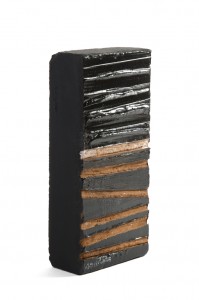
The big winner for the evening was French painter Pierre Soulages (1919 – ). The elder minimalist whose black paintings have succeeded as the European answer to the American 1950s Abstract Expressionists came out far ahead of the pack with a black brick for 60,000 euros. It will make a fantastic gift for the people of Madagascar. I have never much appreciated Soulages’ black paintings, but I was reminded that this was all to build schools, after all. I did have a handful of discussions about how perhaps some dealers might be involved in the auction in order to support their artists’ prices – and with that I was a bit surprised Richard Deacon’s gridded brick, a work not that distant from his sculptures that map out a rooms architecture, only pulled in 4,700 euros. I wondered if the French just didn’t know who he was. But it didn’t really matter. There was plenty of poetry in and on and tossed at these brick works and what better way to spend a Monday evening in Paris – watching (or catching) French people throwing money at bricks.


